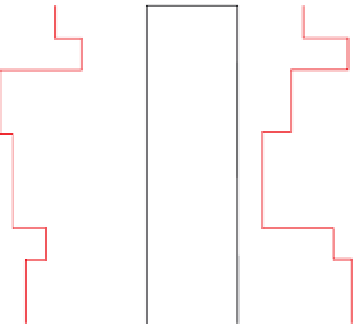Geoscience Reference
In-Depth Information
regolith. The regolith in its entirety is of lower density than
the protolith and often affects gravity responses, especially
through changes in its thickness. The volume of cover and/
or regolith material may not be great, but density contrasts
may be large compared with those at depth and their
in
uence on the gravity reading can be signi
cant, simply
by virtue of the fact that these features are closer to the
gravity meter than the underlying geology.
Where there is a cover of snow and ice, and/or perma-
frost is present, there are associated density contrasts. Ice
and snow are less dense than the underlying rocks, so
where the former are thick they may affect gravity read-
ings. Permafrost is less dense than identical materials filled
with water, although the contrast is normally small and
depends on porosity. Suf
Susceptibility (SI)
Density (g/cm
3
)
10
-4
10
-3
10
-2
10
-1
10
0
2.0
3.0
0
Colluvial
hardpan
Lateritic
residuum
Ferruginous
saprolite
mottled zone
20
40
Saprolite
60
Saprock
80
Bedrock
100
Figure 3.36
Variations in average density and magnetic susceptibility
through overburden and regolith in a greenstone terrain in Western
ciently large areas of greater ice
content may cause signi
cant decreases in gravity.
in each group is signi
cantly larger than the increase, which
is attributed to an increase in magnetite content and the
alteration of biotite and amphibole to pyroxene.
In terms of interpreting gravity data for mineral explor-
ation purposes, regional metamorphic gradients cause rela-
tively small and gradual changes in density which are
unlikely to be significant. The effects of alteration are
important, however, since serpentinisation may cause
ultramafic rocks to have unexpectedly low densities.
3.8.6
Density of mineralised environments
The distribution and variation in density of a mineralised
environment is often complex. Common gangue minerals
such as quartz and calcite have low density. The heavy
elements within metal oxide and sulphide minerals make
these noticeably denser than the rock-forming minerals, at
roughly 4.0 to 7.0 g/cm
3
. Native metals, although some of
the densest substances in the geological environment, are
too scarce to affect the bulk density of their host rocks.
Another dense form of mineralisation is that containing
barite (density
3.8.5
Density of the near-surface
4.48 g/cm
3
). Graphite is a rare example of
low-density mineralisation; bauxite is another. A gravity
survey will respond to the entire ore
¼
Weathering significantly reduces density, and since
weathering is normally greatest near the surface, decreas-
ing progressively with depth, a density gradient is to be
expected. The main causes are increased porosity and the
creation of lower-density secondary minerals, e.g. feldspars
being replaced by clay minerals. Ishikawa et al.(
1981
)
describes an inverse correlation between density and the
degree of weathering in granites, the data de
gangue package but
normally it is the dense ore minerals that dominate,
making the mineralised assemblage denser than its host
Hydrothermal alteration and preferential weathering of
unstable ore minerals, such as sulphides, will usually be
associated with a reduction in overall density of the
affected zone. The same is true for alteration of feldspars
to clay minerals. This is evident in data from the hydro-
thermal alteration zone associated with the General Custer
Mine in the Yankee Fork Ag
-
ning a con-
tinuous variation between that of the fresh material and
that of unconsolidated siliceous sediments (see
Section
lower density than most lithi
ed materials, so the bedrock
Au mining district in Idaho,
USA (see
Fig. 3.57
in
Section 3.9.7
) and the lower gravity in
the Cripple Creek example described in
Section 3.4.7.
Conversely, processes such as propylitisation that create
epidote (density
-
-
cover interface coincides with a signi
cant density con-
trast. Also, density variations within the cover material
may be signi
cant, especially where there is a well-
developed regolith.
Figure 3.36
shows intra-regolith
density variations to be quite large with a dense, and
magnetic,
3.5 g/cm
3
) may lead to an increase in
density, as will deposition of alteration-related minerals in
pore space. These competing effects are the reason that
both positive and negative gravity anomalies have been
¼
laterite horizon occurring at the top of the





























Search WWH ::

Custom Search